Continuous Insulation: Spray Foam Compared to Rigid Boards
Medium-density spray foam insulation can provide better results at less cost
![]() Continuing Education
Continuing Education
Use the following learning objectives to focus your study while reading this month’s Continuing Education article.
Learning Objectives - After reading this article, you will be able to:
- Identify the characteristics of high-performance continuously insulated exterior wall assemblies.
- Compare the characteristics of rigid board insulation with those of medium-density spray foam insulation for use in exterior wall assemblies.
- Investigate the use of spray foam insulation to achieve multiple performance traits in one product including thermal, air, and water resistance.
- Assess the ability of spray foam insulation to be installed with fewer steps and at a lesser cost than assemblies using rigid foam insulation.
The design of exterior wall assemblies has become increasingly focused on performance for greater energy efficiency and resistance to air and water penetration. The 2015 International Energy Conservation Code and ASHRAE 90.1 now require insulation that is continuous in wall assemblies (i.e. not interrupted by studs, framing, etc.) in all eight climate zones within the United States. This push for continuous insulation in exterior wall assemblies is also reflected in green building standards and the desires of building owners to reduce energy costs. The response by many architects has often been to use rigid foam board insulation located over the exterior structural face and behind exterior cladding. While this may be a common choice, it is not the only one. In fact, closer review suggests that using field-applied spray foam insulation, of a medium density, may be a better choice for many situations. This has been found to be true when looked at in terms of design flexibility, performance, construction efficiency, and cost.
Comparison of Foam Insulation Types
Plastic foam insulation has been in use for decades on a range of applications from coffee cups to the Space Shuttle. In buildings, it has been used in the building envelope for insulating walls, roofs, and floors and some specialty applications as well. In many cases, it carries a higher resistance to heat transfer (i.e. R-value) per inch of thickness than other insulating materials such fibrous materials that are blown or installed in blankets/batts. While similar in many ways, there are notable differences across the common types of plastic foam insulation used in buildings, some of which are discussed as follows.
Rigid Foam Board Insulation
These factory-produced, flat sheets of insulation come in a range of standard sizes with common widths of 2 or 4 feet and common lengths of 8, 10, or 12 feet. The most common, un-faced products are manufactured from polystyrene, which is a petroleum-based plastic made from the styrene monomer. Generically, polystyrene is a light-weight material with about 95 percent air trapped in the foam to produce its insulation properties. In practice, there are two types of rigid polystyrene foam plastic insulation boards available—expanded (EPS foam) and extruded (XPS foam). Although both types of insulation are comprised of polystyrene, the two types of manufacturing processes produce finished products with very different performance properties.

Photo courtesy of ICYNENE, Inc.
Spray foam insulation can achieve truly continuous insulation in commercial buildings as required by energy codes, particularly in curved or irregular shaped walls.
Expanded foam (EPS) characteristics. EPS foam insulating sheathing has become a fairly well-known standard product. As an exterior insulating sheathing material, it is non-structural and has been used both above and below grade in addition to roof, floor, and ceiling installations. Different densities are available that can provide the R-value required to meet energy codes.
Extruded foam (XPS) characteristics. XPS is manufactured in a continuous extrusion process that produces a homogeneous closed cell cross section, whereas EPS is manufactured by expanding spherical beads in a mold, using heat and pressure to fuse the beads together. The documented results of this difference in manufacturing process indicate that XPS is more moisture resistant than EPS and holds its R-value better at lower mean temperatures when water is present.
There is a third common type of rigid insulation board used in buildings, namely polyisocyanurate or “polyiso” insulation. Polyiso is a closed-cell, rigid foam board insulation made from a plastic that is similar to, but still different from, polyurethane. It is commonly manufactured into rigid insulation boards consisting of a foam core sandwiched between two face sheets. These face sheets can be composed of organic or inorganic materials with foil or paper and fiberglass being the most common. It is widely used in residential and commercial markets most typically for flat roofing applications.
Spray Foam Insulation
In contrast to rigid, pre-manufactured boards, spray foam is field-applied insulation used in a range of settings, including industrial operations, heating plants, and buildings. Typically, this sprayed insulation is polyurethane based which can be formulated in different densities with different characteristics. Low-density foam weighs about 0.5 pound per cubic foot when installed. It is typically an open cell product which remains somewhat flexible in place and achieves R-values comparable to fibrous insulation. Medium-density foam, as the name implies, is heavier than low-density spray foam, coming in at about 2 pounds per cubic foot, or roughly four times heavier than low-density material. Its other defining characteristic is the closed cell nature of the insulation when mixed. Since it becomes a series of small bubbles (cells) of trapped insulating gas (a blowing agent), the thermal performance is directly enhanced, resulting in an over 70 percent increase in R-value compared to traditional insulation. R-values are possible up to R-7.1 per inch for closed cell spray foam compared to 3.7 per inch for open cell.

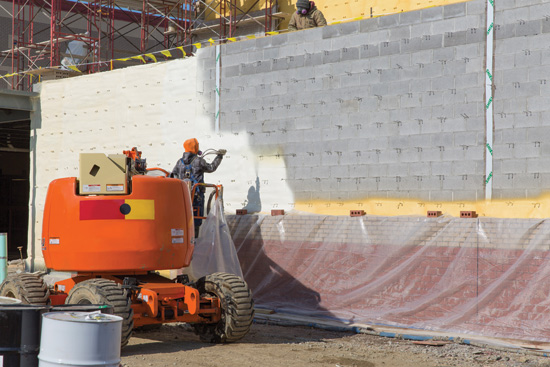
Photos courtesy of ICYNENE, Inc.
Rigid foam boards (top) come in standard sizes and need to be cut and fit into wall assemblies. Spray foam insulation (bottom) is directly applied to the appropriate surface of the wall assembly in the quantity needed.
The make-up of medium-density insulation also allows it to serve as a full air barrier, eliminating the need for a separate product to perform that function. In fact, according to the Air Barrier Association of America (ABAA), many medium-density spray foam insulations are classified as air barrier materials and are the key component in tested air barrier assemblies. Further, in terms of water vapor permeance, it tests as a class II vapor retarder, meaning it has low water vapor permeance. Hence, it has been used in wall assemblies, including stud cavities, to meet the code requirements for a vapor retarder. Additionally, the material serves as a full water resistant barrier as defined in building codes. Collectively, this means that medium-density, closed cell, spray foam insulation provides the performance of four products in one—insulation, air barrier, vapor retarder, and water-resistive barrier. This combination of traits means it not only has the potential to save time and money during construction, it also significantly reduces air leakage, minimizes water and moisture transfer, and optimizes energy efficiency.
Design and Performance Considerations
With an understanding of the basic types of foam insulation products available and their characteristics, our focus can now turn to the selection of those products for use in buildings, specifically in exterior wall assemblies. There are some general design considerations that should be addressed as follows.
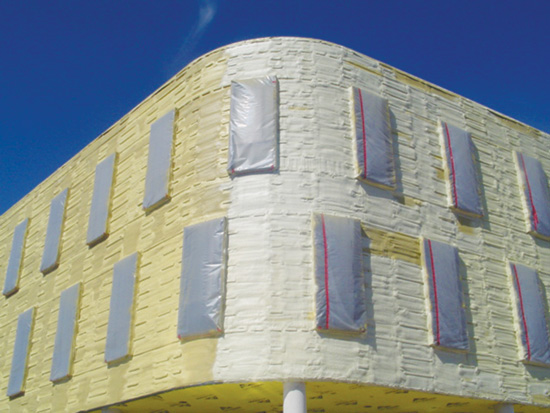
Photo courtesy of ICYNENE, Inc.
Spray foam insulation can be applied to curved and irregular surfaces while also readily sealing around other wall features such as windows.
Continuity Along Wall Shape
Not all buildings are designed to be rectilinear, and even those that are often have some unique or irregular conditions along the walls. Rigid insulation boards are necessarily rectilinear and don't bend or adapt easily to irregular conditions in a wall assembly. Therefore, they may not be a practical or realistic choice for certain buildings where continuity of the insulation is a key design criteria. By contrast, spray foam insulation conforms directly to the surface it is being applied to regardless of shape, geometry, or irregularities. That means that it fully covers and seals over the underlying construction to provide a truly continuous, uninterrupted insulation layer and protective barrier. It also means that buildings designed with intentional curves, domes, arches, angles, or other non-rectilinear shapes no longer need to suffer from lower performance because of limitations from other insulation types. A curved surface for example would be very difficult if not impossible to cover properly with rigid foam board insulation. Mineral fiber batts or blankets do curve and may be used in wall cavities including curved surfaces. However, they do not provide the same performance in terms of insulation level per inch, water resistance, or air resistance. Spray foam insulation would provide excellent performance in all of those areas since its characteristics are not limited or influenced by the shape of the building.
Dimensional Stability
Once in place, all building materials are subject to movement from expansion and contraction due to thermal changes. The less a material moves, the more dimensionally stable it is. Similarly, materials that are formed such as concrete and foam insulation are subject to internal shrinkage as the material cures or ages. Picking an appropriate insulation product that does not suffer from movement in either of these cases is important for sustained, continued performance. Some rigid insulation board product manufacturers are keenly aware of the movement of their products and have issued guidelines for leaving gaps or spaces to accommodate that movement, particularly over large expanses. Of course, doing so does compromise the continuity of the insulation. Similarly, some foam board products may shrink or warp over time which also creates spaces or gaps between the boards.
Polyurethane spray foam insulation by comparison is known for exhibiting minimal, or at worst, acceptable levels of expansion and contraction, even in conditions of extreme relative humidity. That means it has been shown to be very dimensionally stable within wall assemblies in different conditions. Closed cell spray foam insulation is also not prone to cell structure change, which means that shrinkage is rare. This is significant since it is important that the insulation stays in place and does not shrink away from the surfaces it is sprayed onto. Note that buildings can creep or settle, which can impact the performance of foam. In cases where this is a concern, the use of termination bars can be employed to help create a long-term mechanical bond between the spray foam and substrates or membranes.
Fire Resistance
Both spray foam insulation and rigid foam insulation board products are considered combustible, just like many other building materials are. Nonetheless, their installation is allowed in non-combustible assemblies provided that the thermal barrier requirements in the Building Code are met. That means that the insulation needs to be protected and isolated with an appropriate barrier such as gypsum board, masonry, etc. and/or meet specific fire safety code requirements. The standards for determining fire safety are found in several well-known standards.
ASTM E 119 Standard Test Methods for Fire Tests of Building Construction and Materials is intended to evaluate the duration of time that building elements contain a fire, retain their structural integrity, or exhibit both properties during a predetermined test exposure. A wall assembly that incorporates spray foam insulation with a proper thermal barrier can meet the requirements of this testing for fire resistance. In terms of flame propagation, NFPA 285 has become the referenced code standard for exterior wall assemblies. The notable point about NFPA 285 compliance is that it is based on testing the whole wall system, not just the product. Therefore, manufacturers typically prepare, and have independent laboratories test, common wall assemblies using their insulation products and have the results made available for designers to reference. Non-typical assemblies and NFPA 285-compliant walls can be determined on a case-by-case basis relying on engineering evaluations if not actual testing. Hence it may be necessary to consult with manufacturer's technical staff or consultants to determine the suitability of a custom or non-standard wall assembly.
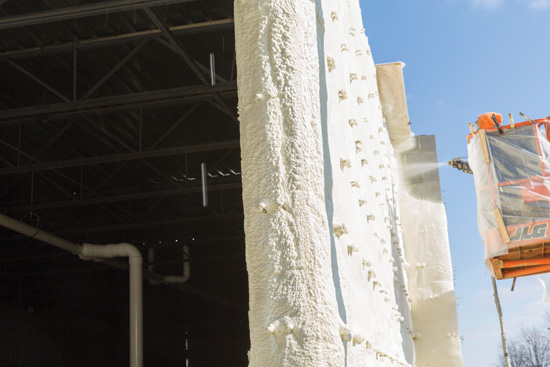
Photo courtesy of ICYNENE, Inc.
Spray foam insulation has been successfully installed to contribute to fire safety and to green building considerations.
It is worth noting when comparing foam insulation products that medium-density spray foam's fire performance characteristics are different than extruded polystyrene foam boards in that the spray foam does not melt at high temperatures. Furthermore, although medium-density spray foam products are considered combustible according to the code, they will not sustain a fire once the fire source is removed.
Cold Temperature Applications.
Rigid insulation board can generally be applied in all temperature ranges subject to the limitations of the expansion and contraction of the material and the temperature tolerance of fastening materials (i.e. adhesives). Similarly medium-density spray foam products can be applied in cold conditions and to cold substrate materials in accordance with installation guidelines. Some are particularly useful for cold weather work since they can be successfully applied to substrates as cold as 5°F (-15°C). This capability makes it an industry leader for winter time use as exterior continuous insulation. Other spray foams have cold temperature capabilities with substrates allowed to be a minimum of 22°F (-5.5°C) for an application. Some contractors are trained to take steps to optimize the installation of foam products. For instance, sometimes an insulation contractor can use certain unique application techniques to compensate for cold weather including “following the sun” and using a thin first pass of material.
Green Considerations
Properly used and installed, all insulation will help reduce the use of energy for heating and cooling in buildings, which will help with sustainable and green building performance. When comparing spray foam and board insulation however, there are several notable differences. First, spray foam can more completely and fully insulate and seal a building without joints, gaps, or other interruptions in the continuous insulation. That can mean better energy efficiency for buildings of all shapes and sizes. Second, there is normally no waste associated with spray foam compared to board insulation since only the amount of material needed is used. Boards often need to be cut to fit producing scraps and waste. Third, since spray foam is delivered in liquid form, a tractor trailer load of it can hold a significantly greater amount of board feet of insulation than a truck load of rigid foam insulation boards.
Finally, the process for producing spray foam insulation compared to board insulation is different not only in the base material used but also in the type of blowing agents used. Those blowing agents have been independently rated and range widely in terms of Global Warming Potential (GWP). Spray foam with 100 percent water blown technology offers the lowest rated GWP of 1. By contrast, XPS chemical blowing agents carry a dramatically higher GWP of over 1,000. It is easy to see which one is more environmentally sustainable based on those numbers.
To elaborate more on the performance issues of rigid and spray foam insulation, we can look further at the three main considerations—thermal resistance, air sealing, and water-resistive barrier properties.
Thermal Resistance
Integrating continuous insulation in exterior wall assemblies has received considerable attention in recent years for many good reasons. Energy codes and standards recognize that this construction approach dramatically increases the effective thermal performance of a wall by eliminating heat flows through non-insulated components such as framing and structural members. This “thermal bridging” as it is referred to, is thus eliminated, resulting in increased wall energy efficiency and greater comfort for occupants. For example, the proper use of an exterior continuous insulation system can result in the elimination of some of the most common thermal bridges that often plague a building, such as direct thermal conductivity through metal or wood wall stud framing, perimeter concrete floor edges, and exposed concrete and steel structural columns and beams. The test of a truly effective continuous insulation system is, therefore, the degree that it fully covers all areas of a building assembly and eliminates thermal bridges.
Outside of the structure, the method of securing and attaching the insulation and the cladding material can become an issue. Rigid insulation that requires mechanical fasteners obviously can compromise the continuity and integrity of the insulation. Using adhesive or other means to secure the insulation in place without penetrating it with fasteners is clearly preferred. With spray foam insulation, this is not an issue since the material has its own adhesive properties to keep it securely attached in place once applied.
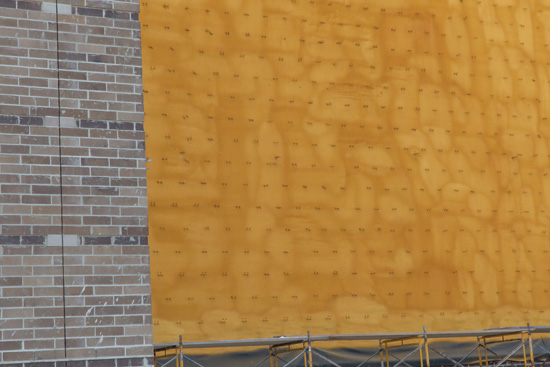
Photo courtesy of ICYNENE, Inc.
As a continuous air and water-resistive barrier, spray foam insulation seals completely around attachments such as these brick ties.
Similarly, connectors or anchors for attaching cladding, whether for thin systems such as metal or fiber cement or thicker systems such as brick and masonry, can be a factor in the wall assembly. Rigid foam boards are commonly available in 2-foot widths for the purpose of fitting above and below such connectors or anchors that are spaced 2 feet apart vertically. Often, that means that there can be a horizontal gap along the joints of the foam boards which compromises the full insulating performance of the system. This can be exacerbated if there are unusual details or irregular shapes along the wall which alter the spacing of the cladding connectors and result in imprecise field cutting of the insulation.
Spray foam insulation, on the other hand, covers and seals around all connectors and attachments completely. There is also greater flexibility with regard to attachment placement and configuration since a slightly bent or misaligned anchor can still be sprayed around without requiring re-alignment. This all minimizes the disruption in the continuity of the insulation, reducing it to only the actual thickness of the attachment materials. Overall, spray foam covers the wall construction completely and creates a much more uniform layer of continuous insulation.
Air Sealing
Anyone who has looked at the true performance drivers of energy efficiency in a wall quickly discovers that unwanted air infiltration is at least as important as thermal resistance if not more so. Energy codes have recognized this phenomenon and now contain mandatory provisions to properly address air sealing of wall assemblies. Since there has been a need to properly define and understand the technical aspects of effective air barriers, the national Air Barrier Association of America (ABAA) has become recognized as the industry resource.
They point out that an air barrier system is a combination of building components within the building enclosure—designed, installed and integrated in such a manner as to stop the uncontrolled flow of air into and out of the building enclosure. They further indicate that effective air barriers have positive impacts not only on heating and cooling costs, but also on moisture problems, indoor air quality, and acoustics. Overall, proper air sealing with an air barrier system results in more sustainable and durable buildings that can reduce greenhouse gas emission.
ABAA also tests and rates air barrier materials which they define based on a tested air permeance rating. To be a qualifying air barrier material, the air permeance must be equal to or less than 0.004 cubic feet of air per minute per square foot of material when tested at an air pressure of 1.57 psf. The testing basis for this rating is ASTM E2178 – “Standard Test Method for Air Permeance of Building Materials.” Most foam insulation, particularly if it is closed cell, qualifies as an air barrier material. Keep in mind, of course, that this test determines the amount of air permeance that migrates through tested materials. It does not address field conditions of holes or gaps in the material. Therefore, ABAA also conducts tests to determine what qualifies as a full air barrier assembly based on ASTM E 2357 – “Standard Test Method for Determining Air Leakage of Air Barrier Assemblies.” In this case, the total tested system must demonstrate performance as a continuous air barrier, perform as a liquid drainage plane, accommodate movements of building materials, and provide connections to adjacent materials to prevent air leakage at all critical locations including connections, joints and penetrations.
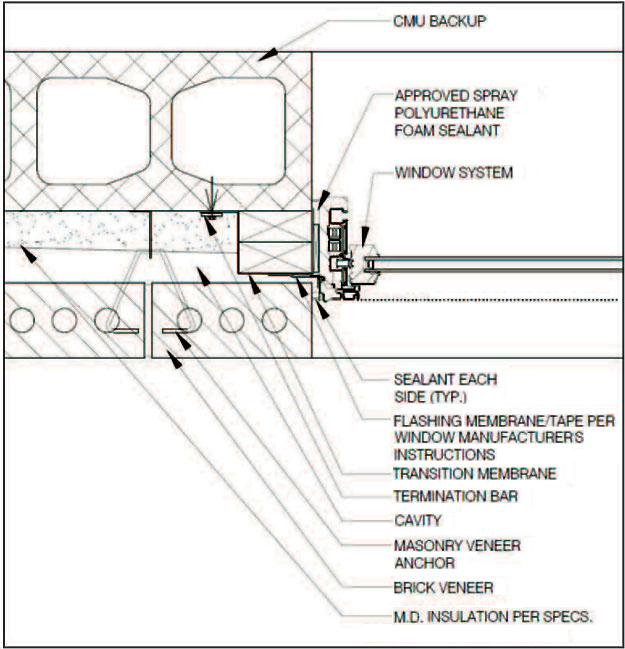
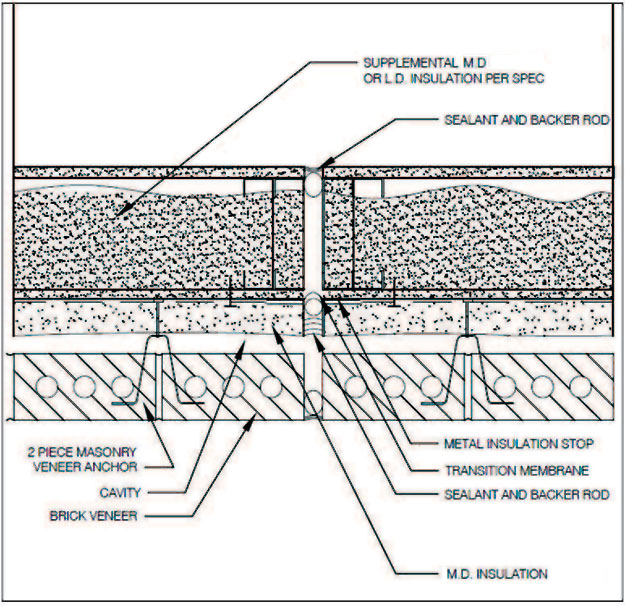
Images courtesy of ICYNENE, Inc.
Critical areas for barrier sealing include window jambs (top) and control joints (bottom) that need to join with transition materials or be separated to allow for building movement.
Among the many rigid foam insulation boards that exist in the marketplace, only four have currently received the ABAA air barrier assembly designation. However, in order to qualify, these products typically require sealants or tape to be applied at all joints and penetrations which can be a very labor intensive process. Furthermore, the sealing tends to get applied on the exterior which is the most challenging location in terms of temperature and humidity changes not to mention quality control of the work being performed. By contrast, virtually all medium-density spray foam products that have been tested have been found to be air impermeable. The thickness where this characteristic is achieved is typically 1.5 inches or less depending on the specific product used. For an exterior continuous insulation application, medium-density spray foam products have the advantage of creating a continuous insulation and air barrier layer in one step. With no board joints to tape or seal, airtight performance becomes much easier to deliver. This is notably true around wall penetrations for mechanical, electrical, plumbing or other components which are a traditional weak point among conventional air barriers. The one step application process generates cost and construction schedule savings compared to the multiple steps of taping, sealing, and filling encountered with other systems.
Part of the testing for a full air barrier assembly requires manufacturers to prove that materials are chemically and adhesively compatible with adjacent materials proposed for use. Those adjacent materials include flashings and membranes commonly found at wall openings such as windows and doors or at wall transitions such as the base of a masonry wall with weep holes. As a result, the transition materials/membranes that are compatible with a particular spray foam manufacturer are also commonly identified by that manufacturer, although they may be made by others. Collectively, the proper use and detailing of spray foam insulation with appropriate transition membranes creates a complete, effective and durable air barrier system. Construction details have been developed by manufacturers to guide architects on how to best accomplish the air barrier assembly using spray foam products. Typical design and implementation recommendations for air barrier system details include:
► Providing transition membranes over flashings and movement joints and tie them in at the rear plane of the foam where the temperature and humidity conditions are most constant.
► Provide termination bars (locking strips) at the leading edges of transition membranes to ensure a mechanical as well as adhesive bond is provided.
► Provide multiple lines of defense at key locations such as control and movement joints.
► Ensure that details allow for expected building movements such as creep and settlement.
Water-Resistant Barrier
Beyond an air barrier, building codes require a water resisive barrier to maintain the integrity of all wall assemblies. Claddings are not universally designed to prevent water penetration and in fact, some are designed to accept and manage water penetration behind the cladding layer. As such, there is a need for a barrier that prevents the water from entering the rest of the wall assembly and causing deterioration or damage. In practice this takes the form of roll or sheet products, self-adhered membranes or liquid applied membranes. Some of these materials may or may not double as an air barrier as well.
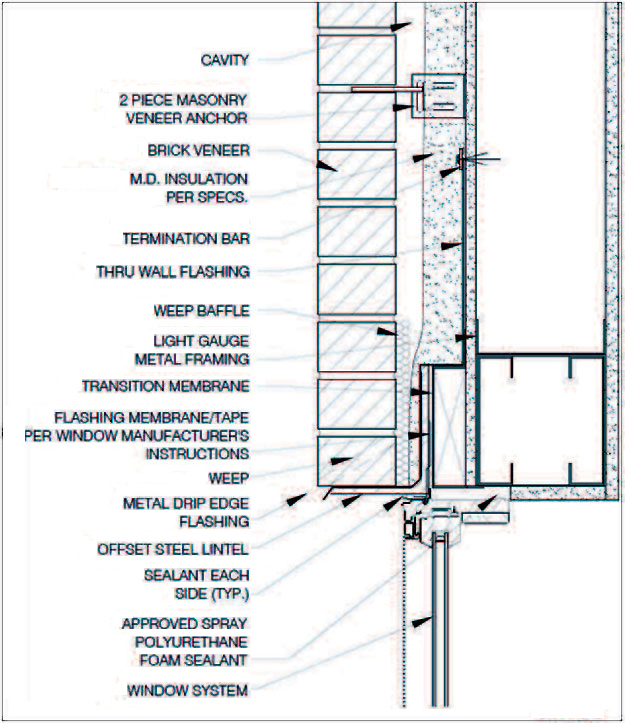
Image courtesy of ICYNENE, Inc.
In this window head detail, the spray foam working in conjunction with the thru wall flashing creates a water-resistive barrier that facilitates any accumulated moisture in the wall cavity to drain out via the weep and drip edge flashing systems
When rigid insulation boards are used such as EPS or XPS, a separate water resistant barrier may be needed since not all of these products are rated to perform this function. In fact some of them will actually absorb water with varying impact on the thermal performance of the insulation. Comparatively, most medium-density, closed cell, spray foam products are considered water-resistive barriers since they have very low water absorption and are capable of shedding water. This is determined by ASTM D 2842 - “Standard Test Method for Water Absorption of Rigid Cellular Plastic.” This test method provides a means for measuring absorption as a result of direct contact exposure to free water for a test period of at least 96 hours with a minimum of 2 inches of water head. Medium-density spray foam products that pass this test and are used as exterior continuous insulation consequently meet the need for a water-resistive barrier. Essentially, any water that gets past the cladding system meets the water-resistive exterior surface of the foam and drains down along the face where it can exit through weep holes or other means. In this way it does not continue progressing into the wall assembly where it could cause damage. Remember that in order to function as intended, flashings are still needed at transitions to ensure proper drainage and meet installation and warranty requirements associated with the penetration. In essence, spray foam insulation can act as the water resistant barrier for the wall field area and then integrate with the flashing at penetrations, openings, or other transition points.
In addition to shedding bulk water, the permeance of water vapor through insulation is a justifiable concern. Current thinking on this topic is that it is not only important to prevent the infiltration of gaseous water vapor into a wall, but also to allow for any that does penetrate to leave so the wall can dry. Medium-density spray foam products can help in this regard. Even though they can become a Class II vapor retarder (at designated thicknesses), most would allow an assembly to dry more easily than the equivalent thicknesses of all faced/skinned rigid foam insulation boards and most un-faced foam boards. Therefore, spray foam provides a wall with greater drying potential (to the outdoors) which should result in enhanced durability and longevity. If having a low water vapor permeance material on the exterior side of a wall assembly is a concern, note that the lesser the thickness of medium-density spray foam, the greater the drying potential of the wall. Also consider that membrane materials can be applied in vapor permeable or impermeable versions, so care is needed to ensure that the correct product is chosen for the wall assembly as its drying potential will be affected. For example, a very low water vapor permeance membrane material (class I vapor retarder) used over an entire wall surface, in conjunction with a rigid foam insulation board application, would restrict the drying of the wall much more than a medium-density spray foam application of significantly greater thickness and thermal performance.
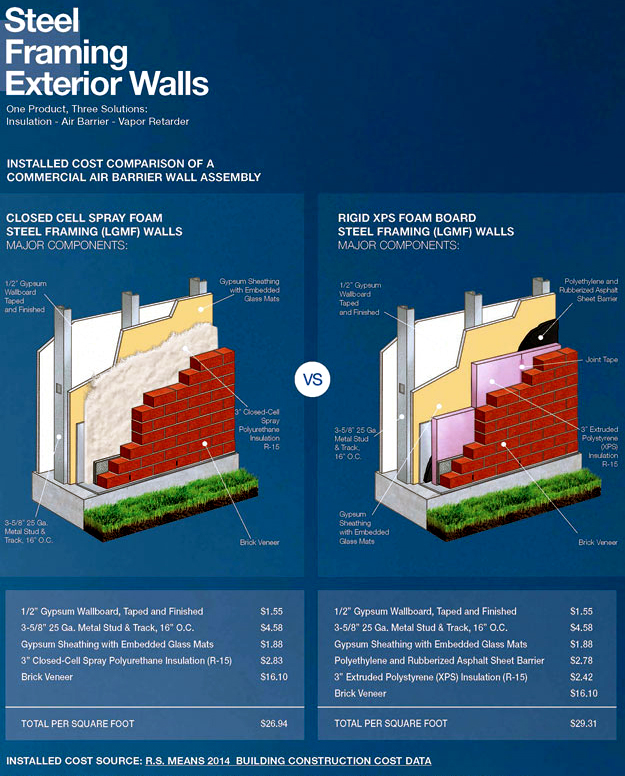
Image courtesy of ICYNENE, Inc.
Comparing the cost of rigid XPS foam with spray foam in a stud wall assembly: Spray foam saves money.
Cost Comparisons
There is a common misperception that spray foam costs more to use in an exterior wall assembly than rigid foam boards. By now it should be clear that the only fair and logical way to compare costs is not solely on the basis of product cost (i.e. cost of spray foam installed compared to cost of rigid foam installed) but on the basis of total wall assembly costs using the two different types of insulation. The most notable difference is that medium-density, closed cell, spray foam insulation provides all three functions of thermal resistance, air barrier, and water-resistive barrier in just one product. Rigid foam board insulation provides at best two of the three functions requiring additional products in order to meet code and perform properly. With that in mind, we look at two examples.
Framed Walls
In commercial buildings, it is common to use metal stud framing with interior and exterior gypsum board on the respective sides. Continuous insulation is provided by placing it over the face of the exterior gypsum board and then installing cladding such as brick veneer as the outermost face of the assembly. If the insulation used is rigid board products, then a water-resistant barrier/ air barrier needs to be installed before the insulation is placed. If medium-density, closed cell spray foam insulation is used, then the additional barrier is not needed.
Cost estimates have been performed for this type of wall assembly using 2014 Building Construction Cost Data published by R.S. Means. In this analysis, the installed square foot costs of finished gypsum wall board, metal framing, exterior gypsum sheathing, and brick veneer cladding are the same regardless of the insulation type used. The difference is in the cost of 3 inches (R-15) of spray foam insulation estimated at a cost of $2.83 a square foot compared to the cost of 3 inches (R-15) of XPS insulation at $2.42 plus a sheet barrier estimated at $2.78. When factoring in all costs, the spray foam wall assembly comes out to $26.94 per square foot compared to the rigid board based assembly estimated at $29.31. That is a difference of $2.37 per square foot or over an 8 percent cost savings on the total wall construction when spray foam insulation is used.
Masonry Walls
Another common exterior wall assembly for commercial construction is based on masonry materials. Typically, concrete masonry units (CMU) are the basis of the main wall with face brick installed as the exterior finish surface. The interior surface may be exposed CMU but more often is finished with half inch thick gypsum board. Continuous insulation is often provided in the cavity provided between the CMU and the brick with brick ties passing through it. Note that masonry has been reviewed by a number of authorities for its water resistant properties and has been found to require a water-resistive barrier in order to fully meet the code requirements. Hence, if rigid insulation boards are used, then a water resistant barrier/ air barrier needs to be installed before the insulation is placed. But since medium-density, closed cell spray foam insulation can be readily used in this wall construction type, then the additional barrier is not needed here either.
Once again comparative cost estimates have been prepared based on the R.S. Means 2014 Building Construction Cost Data. For a typical masonry wall, the installed square foot costs of finished interior gypsum, CMU, and face brick remain the same regardless of the insulation type used. As with the framed wall example, the cost difference is found in the wall system that uses 3 inches (R-15) of spray foam insulation estimated at a cost of $2.83 a square foot compared to the cost of 3 inches (R-15) of XPS insulation at $2.42 plus a sheet barrier estimated at $2.78. When factoring in all costs, the spray foam masonry wall assembly totals $31.93 per square foot compared to the rigid board based assembly estimated at $34.30. This is still a difference of $2.37 per square foot or nearly a 7 percent cost savings on the total wall construction when spray foam insulation is used.
Other exterior wall assembly types are certainly designed and constructed beyond these two examples, but the pattern is clear. There is more than enough cost savings in the multiple performance characteristics of spray foam to overcome any small difference in the pure material costs compared to rigid insulation boards plus additional barrier material.
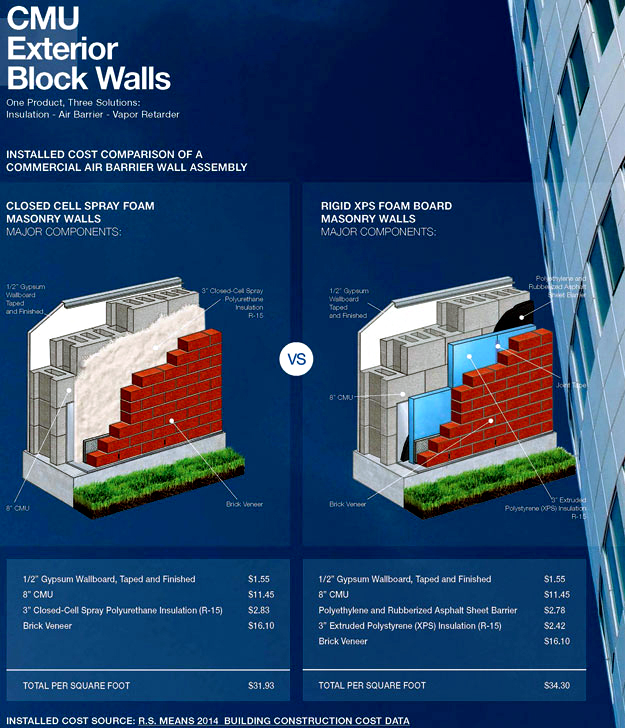
Image courtesy of ICYNENE, Inc.
Using closed cell, medium-density spray foam in a masonry wall is less costly and more time efficient than using rigid board XPS.
Conclusion
Architects and commercial building owners now have the opportunity to maximize their energy savings options with a single product. Medium-density, closed cell spray foam insulation provides a high performance wall assembly solution by combining four functions in one material: truly continuous insulation, a continuous air barrier, a full water-resistive barrier, and a vapor barrier. Further, it has been shown to produce a lower installed cost for a superior thermal, air, and water barrier assembly with less labor and less waste than systems relying on rigid board insulation. From a design standpoint, possibilities are expanded without compromising performance, particularly for curved or irregularly shaped buildings since spray foam can readily adhere to curved, irregular, or unique shapes and conditions. The end result offers greater architectural design flexibility for continuous insulation solutions and better outcomes for building owners and occupants.
 |
The evolution of insulation starts here. ICYNENE's spray foam insulation products are specially formulated to meet the needs of builders, architects, and homeowners. www.icynene.com |
